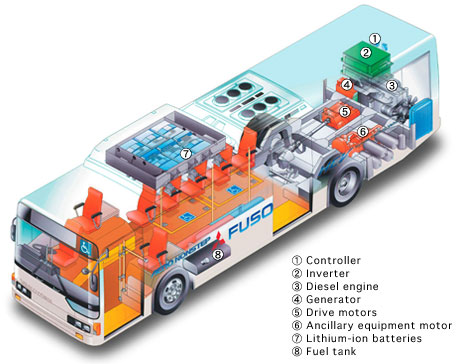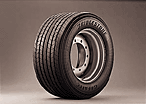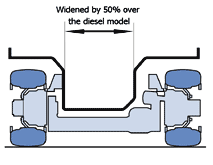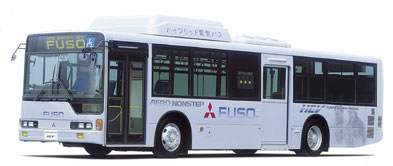Tokyo, 23 February 2004-Mitsubishi Fuso Truck & Bus Corporation will launch the Aero Non-step HEV(superscript: 1) large size public service bus at Mitsubishi Fuso dealers throughout Japan on 23 February 2004. The Aero Non-step HEV will be the first public service bus in Japan powered by a series-type hybrid propulsion system, which uses electric motors to drive the wheels and an engine to generate electricity thereby realizing significant reductions in emissions, fuel consumption and noise. The fact that the engine runs on diesel oil, the fuel most commonly used by commercial vehicles, makes Aero Non-step HEV a highly practical LEV bus to operate because it is able to utilize the existing infrastructure.
(superscript: 1) Hybrid electric vehicle
Main features
- Powered by Japanís first volume production HEV system(superscript: 2) that employs existing infrastructure resources, making it operable throughout the whole of the country.
- Cutting emissions by half, Aero Non-step HEV is 8-Tokenshi(superscript: 3) J-LEV certified for its outstanding environmental performance.
- The step-less floor and the generously wide aisle over the rear axle, which results from the use of super single-tires, meets the barrier-free requirements of Japanís aging population.
(superscript: 2) Series hybrid electric powertrain
(superscript: 3) The Eight Metropolitan Prefectural / Municipal Authorities Low-Emission Vehicle Certification System (covering the prefectures of Saitama, Chiba and Kanagawa and the cities of Tokyo, Yokohama, Kawasaki, Chiba and Saitama); |
|
|
| 1.Development aims |
As atmospheric pollution becomes more serious, there is a growing call for public service buses operating in urban areas to reduce particulate emissions and fuel consumption (thereby reducing CO2 emissions), thereby improving operating economies and preventing global warming. There is also an increasing need for buses to incorporate step-less floor and other barrier-free design principles to facilitate access to and from and movement inside the bus as the mean age of Japan’s population rises.
Mitsubishi Fuso has developed its own hybrid electric vehicle (HEV) propulsion system to meet such demands. The Aero Non-step HEV has been developed to employ existing infrastructure resources and thus promote the spread of LEVís on Japanís roads. It achieves improved harmony with the environment by using a diesel engine to generate electric motive power, thereby realizing significant reductions in emissions, fuel consumption and noise. At the same time, the streamlined layout of its hybrid propulsion system brings major improvements in passenger convenience, comfort and ease of movement inside the vehicle. |
| 2. Product feature outline |
| (1) Series-hybrid propulsion system for public service buses |
|
Aero Non-step HEV is powered by the series-hybrid system, which employs a diesel-fuelled engine as a generator and electric motors to drive the wheels. The engine operates at a fixed speed that returns optimum fuel consumption and emissions performance. The high-efficiency, high-power lithium-ion batteries provide sufficient motive power to drive the Aero Non-step HEV both along flat roads and also to move off from stationary with the engine stopped. When the driver applies the brakes, the system also efficiently recovers kinetic energy and converts it into electricity that is then stored in the batteries. This system enables Aero Non-step HEV to return much improved emissions performance and mileage, with particulate matter (PM) emissions over 50% lower than Japan’s New Short-term Emission Regulations standard, and fuel consumption that is 40% better than its diesel-powered counterpart. |
 |
| HEV system outline diagram |
| Moving off, slow-speed driving |
-
Aero HEV uses electrical energy stored in its batteries to move off and drive at slower speeds.
- Conventionally powered buses use the engine to supply power to operate the brakes, steering and other ancillary equipment. Aero Non-step HEV, however, can power these systems from its batteries even with the engine stopped.
|
| Battery-stored power drops |
- When power stored in the batteries drops to a predetermined level, the generator engine automatically starts operating to recharge the batteries. At such times, the generator engine operates at a fixed speed that delivers optimum fuel efficiency and emissions performance.
- When accelerating, climbing a gradient and other high-load conditions, the electric motors use current supplied both by the batteries and by the engine generator.
|
| Braking |
- When the driver applies the brakes, the electric motors turn in reverse and act as generators, recovering kinetic energy and transforming it into electricity.
- Operation of the electric (regenerative) brakes and main service brakes is coordinated electronically and braking energy is efficiently recovered until vehicle speed approaches zero.
|
| (2) Outstanding emissions performance gains J-LEV certification |
The Aero Non-step HEV bus’s series-hybrid driveline employs the engine solely to generate electricity, operating at an optimum-efficiency fixed speed that is unaffected by vehicle speed or loads. Using the drive motors as regenerative brakes also reduces the time the generator engine is required to operate. This results in a significant reduction in emissions compared with conventionally powered buses in which the engine operates over the full speed range. Reducing NOx emissions by 68% and particulate matter (PM) emissions by 76%, Aero HEV’s environment-friendly performance earns it J-LEV(superscript: 4) certification under the 8-Tokenshi(superscript: 1) and the Tokyo Metropolitan LEV systems.
Aero Non-step HEV is also fitted as standard with Mitsubishi’s Idling Stop & Start system that cuts out the engine when the bus is stationary at traffic lights or when passengers are alighting or boarding. This brings further improvements in fuel consumption and emissions performance.
(superscript: 4) 'PM emissions 50% lower than New Short-term Emission Regulation requirements
|


8-Tokenshi J-LEV mark
|
| (3) Step-less floor body meets barrier-free society needs |
|
Aero HEV uses a body construction that eliminates steps in the floor between the front and center doors. The door step height of just 300mm facilitates boarding and alighting for passengers. An optional kneeling system lowers nearside ground clearance by 70mm to make it more user-friendly still. In compliance with Japan’s Barrier Free Traffic Law, Aero HEV is also fitted with a deployable ramp for wheelchair users. |
| (4) New ultra-low aspect single-tire rear wheels |
Aero HEV is the first production bus in Japan to use single-tire rear wheels fitted with ultra-low aspect tires (made by Bridgestone), thus reducing weight and fuel consumption. Together with the compact layout of the high-output motors, this has enabled the aisle width over the rear axle to be widened by 50% over the diesel model without requiring any changes to axle or suspension design.
 |
Size: |
435/45R22.5 |
| Weight: |
20% lighter than double-tires used ondiesel model |

Wider floor over rear axle
|
| (5) Reliability verified in pre-launch on-road operation trials |
The Aero Non-step HEV announced today became the first series-hybrid public service bus to be operated in Japan in a pre-launch operation test program that started in June 2002. Ensyu Railway Co., Ltd. first used Aero Non-step HEV buses to carry passengers between the Shizuoka Ecopa Stadium and the Kakegawa Station during the 2002 Soccer World Cup. The company has continued to operate the buses on regular public service routes in Hamamatsu City after the World Cup.
As of September 2003, Aero Non-step HEV’s had driven a total of 50,000 km without any mechanical trouble, thereby proving the reliability of Mitsubishi Fuso’s HEV system. And with its electric motors eliminating the need for a clutch, Aero Non-step HEV has proved very popular with the company’s bus drivers for its outstanding drivability. Aero Non-step HEV was on display as a test-drive vehicle at the 2003 Tokyo Motor show where it impressed many hundreds of visitors with its smooth, shift jerk-free moving off and acceleration and with its wide step-less floor and quiet interior.
|
| 3.Sales target |
| 50 vehicles/year |
| 4.Manufacturer░s recommended price |
| Model type |
Price |
| MP37JM (Modified) 68 passenger bus |
39,800,000 yen |
(Tokyo delivery; as at February 2004; exclusive of consumption tax) |

![]()
![]()